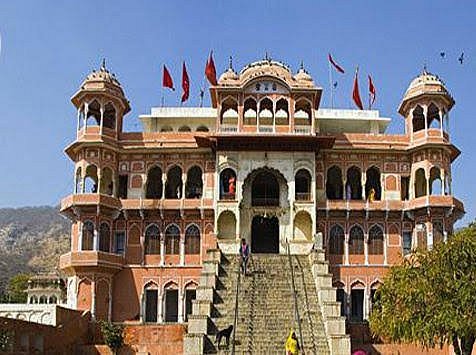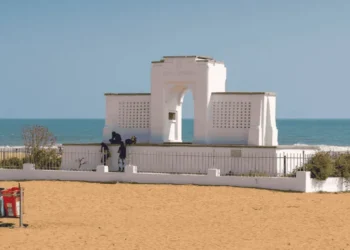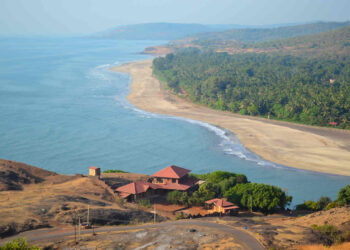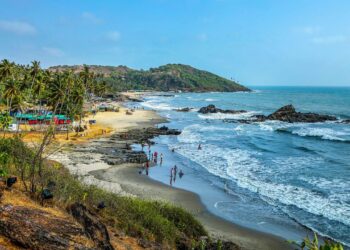The Mehandipur Balaji Temple, in Mehandipur village, Karauli district, Rajasthan, is a sacred Hindu shrine dedicated to Lord Hanuman. Located on the Jaipur-Agra highway, 103 kilometers from Jaipur, it sits between Karauli and Dausa districts. It is famed for its unique rituals to banish evil spirits drawing thousands seeking Hanuman’s divine strength.
History of Mehandipur Balaji Temple
The Mehandipur Balaji Temple began over 1000 years ago and is tied to a divine vision. Village tales say the Hanuman idol, known as Balaji for his child form, appeared on its own in the Aravalli hills, once a thick forest with leopards and snakes. Shri Ganesh Puri Ji Maharaj, a holy saint, dreamed of Hanuman, Pret Raj Sarkar (king of spirits), and Bhairav Ji, who instructed him to build a temple. By the 11th century, a small shrine stood, later expanded by local kings in the 1600s. Mughal raids damaged it, but devotees rebuilt it in the 1800s with marble and stone. The Shri Mehandipur Balaji Trust now operates the temple, hosting around 5000 daily visitors and 50,000 during Hanuman Jayanti. A story tells of a blind boy healed after prayers here, spreading the temple’s fame for miracles.
Architecture of Mehandipur Balaji Temple
The temple spans 3 acres in Mehandipur, nestled between two Aravalli hills. Built in the Rajput style, it uses red sandstone and white marble. The 50-foot structure has one dome with a gold spire. The complex has four chambers: the first two hold 4-foot marble idols of Hanuman (Balaji) and Bhairav Ji, while the third and fourth, called Pret Raj courts, are for spirit-cleansing rituals, per temple guides. The sanctum, 10 meters by 10 meters, has silver-plated walls. A 300-meter marble courtyard surrounds a 5-meter kund (water tank) for holy dips. The main gate, 8 meters tall, shows carved peacocks and flowers. A 200-meter path leads to a well for ritual water. Over 50 dharamshalas and a parking lot serve visitors who come to visit the temple.
Sculptures and Carvings
The temple’s houses a 4-foot swayambhu Hanuman idol, a self-manifested stone covered in vermillion and ghee, holding a mace with a youthful face, unlike other Hanuman idols. A 3-foot black stone Bhairav Ji idol stands in the second chamber. The Pret Raj courts have no idols but feature 2-meter stone slabs with mantra carvings. The sanctum’s silver walls, added in the 1800s, show 1-meter panels of Ramayana scenes, like Hanuman lifting the mountain. The main gate’s 6-meter pillars have lotus designs in marble. A 3-foot white marble Ram-Sita idol faces Balaji, showing Hanuman’s unwavering loyalty and devotion.
Rituals and Worship
The Mehandipur Balaji Temple is known for exorcism and healing, especially during Hanuman Jayanti (April), Dussehra (October), and Tuesdays/Saturdays, Hanuman’s holy days. Balaji, Pret Raj Sarkar, and Bhairav Ji are believed to free devotees from evil spirits. Priests perform special rituals: Darkhast involves offering two plates of 4–5 laddoos to Balaji’s fire—one for blessings, one for wishes. Arji, offers laddoos, black urad, and rice for severe troubles, per temple rules. Savamani, after fulfilled wishes, gives 50 kilos of halwa-puri to the poor.
Things to Do at Mehandipur Balaji Temple
Join Rituals: Offer Darkhast or Arji during Hanuman Jayanti to seek blessings or watch priests perform spirit-cleansing rites.
Explore the Temple: See the swayambhu idol, silver walls, and kund.
Visit the Well: Draw water from the temple well, believed to hold Balaji’s power.
See Nearby Sites: Visit Chand Baori (20 km), a 10th-century stepwell, or Harshat Mata Temple (20 km).
Visiting Information for Mehandipur Balaji Temple
How to Get There
The temple is in Mehandipur, 103 kilometers from Jaipur, with several travel options.
By Plane: Jaipur International Airport, 62 kilometers away, links to Delhi (1 hour, ₹3000–8000) and Mumbai (2 hours, ₹4000–10000). Taxis or buses take 2 hours.
By Train: Bandikui Junction, 36 kilometers away, connects to Delhi (4 hours, ₹150–600) and Jaipur (1.5 hours, ₹100–300) via trains like the Ajmer Express. Autos or taxis take 40 minutes.
By Road: NH-21 joins Mehandipur to Jaipur (103 km, 2 hours) and Agra (125 km, 3 hours). Buses cost ₹50–150; taxis cost ₹1000–2000. Parking is 500 meters away.
Best Time to Go
October to March, with cool weather (10–25°C), is best. Hanuman Jayanti and Dussehra draw 50,000 visitors, per trust logs, with intense rituals. Early mornings, especially Tuesdays, are calm. Summers (April–June, 30–45°C) are hot while monsoons (July–September) make roads muddy.
Rules for Visitors
Better to wear modest clothes. For men you need need shirts and trousers or dhotis while women need sarees or suits with dupattas. Remove shoes at stands; leave leather items outside. Avoid eating or drinking inside, including prasad, which must be left in the fire or left for birds. Don’t look back when leaving, as spirits may follow, per local belief. No photography or videography is allowed inside. Avoid giving money to priests or touching strangers. Better to follow a vegetarian diet (no onion, garlic, meat, or alcohol) before and after visiting.
Cultural Significance
The Mehandipur Balaji Temple is a spiritual cornerstone in Rajasthan, part of a circuit with Salasar Balaji and Khatushyamji temples. Its exorcism rituals draw devotees from Haryana and Uttar Pradesh. The temple’s healing fame, tied to stories like the healed blind boy, attracts scholars and pilgrims, preserving Rajasthan’s mystical heritage. Hanuman Jayanti brings Rajasthani bhajans and folk dances, with families offering laddoos. Stalls sell vermillion and vegetarian thalis, blending faith with local life.
Conclusion
The Mehandipur Balaji Temple in Karauli, Rajasthan, is a unique shrine of Hanuman’s divine power. Its swayambhu idol, Rajput architecture, and healing rituals make it a beacon for spiritual belief for countless devotees. For those seeking freedom from spirit afflictions or Rajasthan’s sacred legacy, this temple should be a must-visit.











